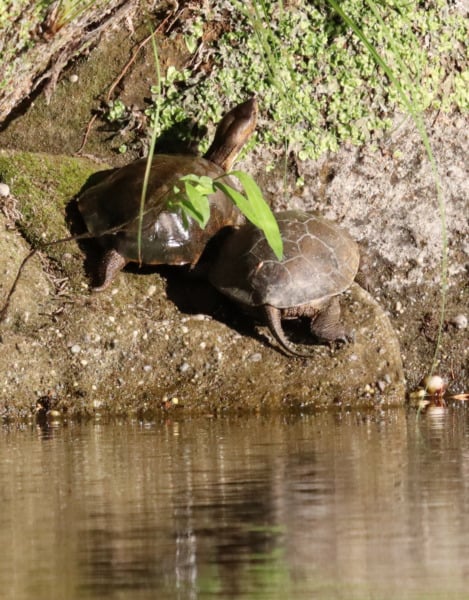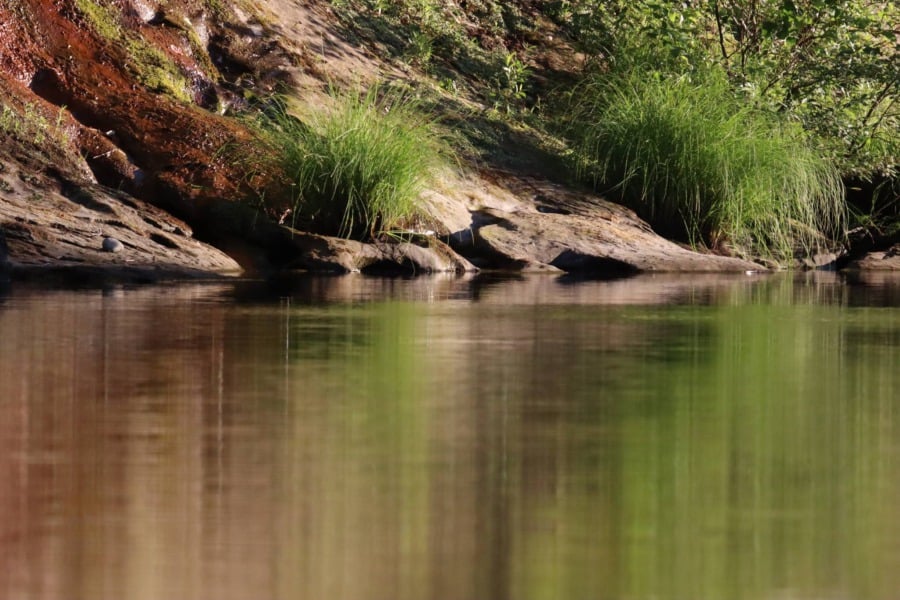Echoes of the Past: Northwestern Pond Turtles in the Eel River Habitat

Northwestern Pond Turtles on the bank of the South Fork of the Eel River [Photos by Kim Cabrera]
– Shell: Northwestern Pond Turtles have a distinctive, marbled shell that ranges in color from olive to dark brown. Their carapace is smooth and oval-shaped, offering them a unique appearance among freshwater turtles.
– Size: Adults typically measure between 5 to 8 inches in shell length. Males tend to be slightly smaller than females.
– Sexual Dimorphism: Males and females can be distinguished by physical traits. Males usually have a more concave plastron (the underside of the shell) and longer tails, while females have a flatter plastron and shorter tails. Males also exhibit brighter eye coloration compared to females.

Living in a painting: The Northwestern Pond Turtle, native to the west coast, inhabit the picturesque waters of the Eel River.
Habitat:
– Northwestern Pond Turtles are found in a variety of freshwater environments, including slow-moving rivers, streams, ponds, and marshes. They prefer areas with abundant vegetation and basking sites, such as logs or rocks.
– The South Fork of the Eel River, with its diverse aquatic habitats and rich biodiversity, provides an ideal environment for these turtles. The river’s backwaters and vegetative cover offer essential nesting and basking sites.
Diet:
– These turtles are omnivores with a varied diet. They feed on aquatic vegetation, insects, small fish, crustaceans, and carrion. Juvenile turtles tend to consume more protein-rich prey, while adults incorporate more plant material into their diet.
Behavior and Ecology:
– Northwestern Pond Turtles are primarily diurnal, meaning they are active during the day. They spend a significant amount of time basking in the sun, which is crucial for thermoregulation and shell health.
– During colder months, they hibernate underwater or in mud, slowing their metabolism to survive the winter.
Reproduction:
– Breeding season for these turtles typically occurs in the spring and early summer. Females lay their eggs in sandy or soft soil, often some distance from water. The clutch size ranges from 3 to 13 eggs, which hatch after an incubation period of about 80 to 90 days.
-Like many other turtle species, the gender ratios of Western Pond Turtle hatchlings are influenced by the incubation temperatures of their nests. The pivotal temperature to achieve an equal ratio of male and female turtles is around 84.9 degrees Fahrenheit. This means that global warming poses a significant threat, as rising temperatures can skew these ratios and impact the population dynamics.
Conservation Status:
– The Northwestern Pond Turtle faces several threats, including habitat loss, pollution, and predation. The biggest natural threats to this turtle, its eggs, and hatchlings are raccoons, otters, ospreys, and coyotes. Weasels and large fish are also common predators. Additionally, non-native predators such as bullfrogs, crayfish, and opossums pose significant risks.*
Conservation efforts are crucial to protect their habitats and ensure their survival.
– Initiatives such as riparian restoration and public education are vital for the conservation of these turtles and their environments.
Want to learn even more about our local animals? Subscribe to Kim Cabrera’s YouTube Channel.
*Note- This sentence was added post-publication for clarification purposes.

Join the discussion! For rules visit: https://kymkemp.com/commenting-rules
Comments system how-to: https://wpdiscuz.com/community/postid/10599/
I spotted one many years ago, in summer and only the one time, in Miller Creek west of Briceland.
River otters are the biggest threat to their existence.
Are you sure about that? Fish and crawdads are their favorite.
I never seen one eating a turtle ?
A group of 8 otters came up the creek after cleaning out the neighbors pond…low water so the land locked steelhead almost got wiped out, just now seeing tiny ones…no waterdogs and yes…no turtles…they continued all the way up sream wiping everything out in the intermittent pools, that’s where we saw turtles when hunting, they seemed to want to go to the origin of the water. Anything left of the turtles gets packed off and chewed up. When they came back down stream they were in a hurry, what a strange noise when they thrashed through the dead leaves.
there used to be a pond off the Yager that had them..Very wary. You had to be very quiet to catch a glimpse of them.
Raccoons aren’t native to this area?
No, they’re native, my writing was unclear, and I didn’t catch it. Raccoons and non-native bullfrogs, which I found interesting that either of those were turtle predators, but I replaced the sentence with a clearer (I hope) and more elaborate list of turtle predators.
Fucking raccoons~
I’ve seen these guys many times in many different locations. Most recently they were sunning themselves in a manmade pond up Kidder Creek Rd. in Scott Valley.
It’s non-natives that upset the balance. Most systems work until something alien shows up in the mix.
Possums are mostly ignored as villains, but do enormous damage to many species in our area. One of the biggest reasons for decline of plovers and anything that lays eggs on or close to the ground.
The fur trade that lasted a few centuries upset things allowed some non marketable but delicious species to thrive…..God help you if you kill or harass a marine mammal now, a legal and regulated industry would help some yummy stuff survive. The hate mail would be fun
Flew the mouth of the Eel last fall and saw maybe 75 sea lions.
Flew the same ground and saw 1500, forty years ago.
It doesn’t take a degree to get some accurate conclusions.
Probably no salmon .
Yeah that is the only animal I have killed my own self in person;
eating the chickens
vicious!
Pond turtles can show up on our beaches after winter river freshets. If you find one on the beach, where they are preyed on by seagulls and corvids, you might consider transporting them back to the river.
Thank you for a very informative and sweet article
Turtle takes four breaths per minute and lives 100 years; dog takes thirty breaths per minute and lives 13.
Western pond turtles (Actinemys marmorata) can live up to 70 years in captivity, but in the wild their lifespan is estimated to be between 50 and 70 years. They reach reproductive maturity at around 10 years old, when their carapace is about 5 to 6 inches long.
Tortoises are the longest-living land animals in the world, with an average lifespan of 80–150 years. However, some species can live even longer, up to 250 years.
Google dot com
Inspired by this story to ‘sign up’! Plenty of brutality amongst the masses yet some lovely Posters too so we’ll see how it goes.. early years swimming in the Trinity on such a lovely day swam upon a Turtle, unsure if it was a Pond Turtle, but the little fella was flying along so happily and free through the waters, I followed along in awe of Nature’s wild beauty, humbled me to my connection in this living breathing Planet and changed my Soul in a profoundly delightful way I had no way of anticipating . Thank you Turtle. I hope you persevere through Humans’ destructive way of being.
Welcome and thank you for a bit of pure joy.
Found one in the middle of the road on the avenue once. It seemed to be old and beat up. Took it home and named it “The Terminator”. Two days later it escaped.